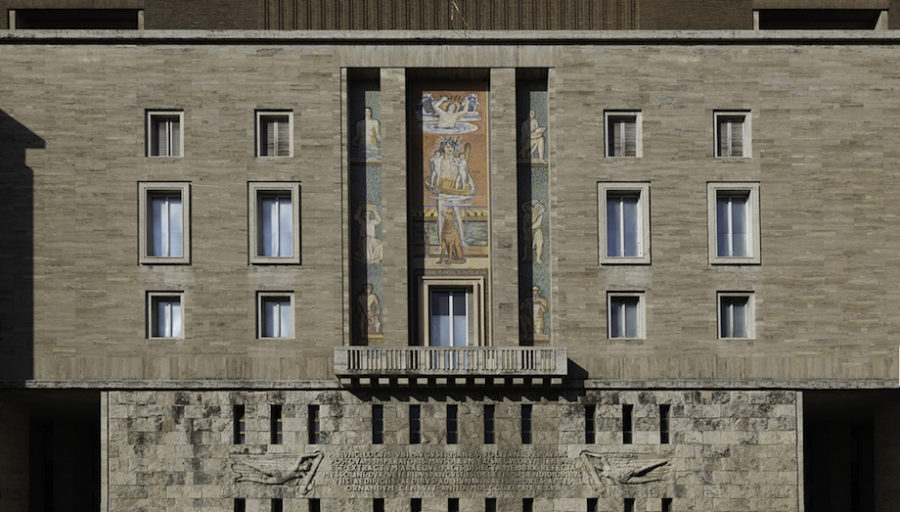
CULTURE

ZHA Videography: Henry Virgin
船舶業界における環境負荷ゼロ・エネルギーへの転換を推し進めるため、〈NatPowerH 水素充填ステーション(NatPowerH Hydrogen Refuelling Stations)〉が地中海に誕生します。
再生可能エネルギー開発に取り組む NatPowerグループの一員であるNatPower H社とザハ・ハディド・アーキテクツ(Zaha Hadid Architects、以下ZHAと表記)によるプロジェクトであり、2024年夏からイタリアの25カ所のマリーナと港に設置が開始され、今後6年間で地中海全域に100カ所の設置を目標に掲げています。
ZHAによる、石積み技術と3Dプリントを融合した研究を反映した乾式の構造体であり、再構築が可能な建築です。
海外にみる 3Dプリント建築2.0 | 住宅供給や既存の技術を革新する 3Dプリントを通して未来を見据えるプロジェクト10選
(以下、ZHAから提供されたプレスキットのテキストの抄訳)

Render by Tecma Solutions
発電コンサルタント企業とともにつくるボートのための水素ステーション
〈NatPowerH 水素充填ステーション〉は、イタリアの25カ所のマリーナと港に設置される、世界初のグリーン水素ステーションである。
再生可能エネルギー開発に取り組むイタリア・ミラノの発電コンサルタント NatPowerグループの一員であるNatPower H社が主導する1億ユーロの投資により、このグリーン水素インフラは2024年夏から設置が開始される。レジャーボートで世界的に人気の高い地域にさらに拡大するため、今後6年間で地中海全域に100カ所の水素充填ステーションを設置することを目標としている。
風力、太陽光、その他の再生可能エネルギー・インフラを利用して製造されるグリーン水素は、持続可能な電力源に対する世界的な需要の高まりに応える無限の可能性を提供するNatPower H社の技術を用いて、安定した天然資源へと変換される。

Circulation Diagram
水蒸気と暖かい空気だけを放出する水素は、燃料電池で電力を生み出す。2030年までに100カ所の水素充填ステーションが稼動すれば、年間3650トンのグリーン水素が供給され、地中海のレジャーボートから毎年約4万5000トンもの温室効果ガスの排出を削減する。
NatPower H社は、「安全性」「拡張性」「持続可能性」という3つの主要原則に基づき、グリーン水素燃料ソリューションを開発した。NatPower H社の水素ステーションは、RINA PED認証の船舶用低圧メタルハイドライド技術を駆使して水素を供給する。循環性と海洋生態系の保護に細心の注意を払いながら、業界規制と認証に準拠したコンパクトさと安全性、弾力性を確保する。
船舶業界では、より持続可能な船舶に対する要求がますます高まっており、世界の造船所は、事業による生態系への影響を低減するためのソリューションで対応している。

Render by Tecma Solutions
世界的なエネルギー転換を推し進める水素充填ステーション
ディーゼルエンジンの使用を禁止する海洋保護区が世界各地に設定されたことは、業界における生態学的に持続可能な開発の重要性を浮き彫りにした。この急速なエネルギー転換は現在、環境負荷ゼロのエネルギーの配給と燃料補給のためのインフラが不足しているために妨げられているのである。
グリーン水素を供給するインフラを設置することで、NatPower H社は、イタリアの主要なマリーナに持続可能なエネルギー・ハブのネットワークを構築し、水素を動力とする船舶の継続的な開発と利用を促進する理想的な条件を確立することを目指している。
NatPower H社はZHAと協力し、環境に優しく、最高の安全基準を満たす水素ステーションを建設する。ZHAのモジュラー・システムに関する研究に基づいた設計により、地中海沿岸のさまざまな場所に適応可能で、全体の大きさ、座席、自転車充電設備、各港やマリーナ内の歩行者通路など、その土地特有のニーズに基づいて、各充填ステーションをカスタマイズすることができる。

Render by Tecma Solutions
3Dプリントした部材を乾式で組み合わせる、再構築が可能な建築
各構造物のセグメントを作成するために3Dロボットによる材料配置を利用することで、ステーションは完全にリサイクル可能な乾式組み立ての石積みとなり、建設廃棄物を最小限に抑えながら材料効率も向上している。
3Dプリントされたブロックの層構成は、地中海の景観や海洋生態系に見られる自然の地層の筋状の構造や流動的な形状を生み出す自然界のプロセスを反映している。

Circular Construction
この充填ステーションのデザインは、ZHAのコンピュテーショナル・デザイン研究グループ(ZHA CODE)が、チューリッヒ工科大学(ETHZ)のブロックリサーチグループおよびインクリメンタル3D(incremental3D)と共同で研究した、無筋石積み構造、3Dプリント・コンクリート、持続可能なデジタル・コンクリート構造から発展した。
ヴェネチアの〈Striatus〉や、リヨンのホルシム・イノベーション・ハブに設置された〈Phoenix〉がその例である。コンピュテーショナルデザインと3Dプリントを統合した循環型の構造体は、簡単に分解し、リサイクル可能なブロックを使用することで、性能に妥協することなく必要な構造材を最大50%削減する。
乾式×3Dプリントコンクリート橋の進化形〈Phoenix〉ザハ・ハディド・アーキテクツ、ホルシム、ETHZ、インクリメンタル3D、フランス
ZHAのディレクターであるフィリッポ・イノチェンティ(Filippo Innocenti)は次のように語る。
「低炭素コンクリートで建設されたZHAの水素充填ステーションの構造強度は、材料の使用量を増やすのではなく、形状によって生み出される。最新の建設技術と、2000年以上前にローマ人によって地中海沿岸で開発された歴史的なエンジニアリングを融合させたこのステーションは、先進的な循環型建築技術を採用しており、NatPower H社によるエコロジーに配慮した未来へのコミットメントを反映している。」
以下、ZHAのリリース(英文)です。
Project: NatPowerH Hydrogen Refuelling Stations
Date: 2024
Client: NatPowerH
Status: Detail Design
Size: 50m²The world’s first green hydrogen refuelling infrastructure for the recreational boating industry will be initiated in 25 Italian marinas and ports with stations designed by Zaha Hadid Architects (ZHA).
A €100 million investment led by NatPower H, part of the NatPower group, the green hydrogen infrastructure will begin installation in the summer of 2024 and targets the provision of 100 refuelling stations throughout the Mediterranean over the next six years, with further expansion to the world’s most popular regions for recreational boating.
Produced with wind, solar and other renewable energy infrastructure, green hydrogen is converted into a stable, natural resource using NatPower H technologies offering unlimited possibilities to meet the ever-increasing global demand for sustainable sources of power. Emitting only water vapor and warm air, hydrogen generates electrical power in a fuel cell. The 100 refuelling stations operational by 2030 will deliver up to 3650 tons of green hydrogen annually, eliminating approximately 45,000 tons of greenhouse gas emissions from the Mediterranean’s recreational boats every year.
NatPower H has developed a green hydrogen fuel solution based on three key principles: safety, scalability and sustainability. The NatPower H stations will supply hydrogen using proven RINA PED certified low-pressure metal hydrides technologies for marine applications that ensure compactness, safety and resilience in compliance with industry regulations and
certifications together with a meticulous focus on circularity and the protection of marine ecosystems.The boating industry is increasingly demanding ever more sustainable vessels and the world’s shipyards are responding with solutions to reduce the ecological impact of their operations. The demarcation of protected marine areas around the world which now prohibit the use of diesel engines underscores the importance of ecologically sustainable developments in the industry. This rapid energy transition is currently held back by the lack of infrastructure for distribution and refuelling with zero-impact energy sources.
Installing the infrastructure to deliver green hydrogen, NatPower H aims to create a network of sustainable energy hubs in all major Italian marinas and establish ideal conditions to facilitate the ongoing development and use of hydrogen-powered vessels.
NatPower H is collaborating with ZHA to construct green hydrogen refuelling stations that are ecologically responsible and meet the highest safety standards. Drawing on ZHA’s research into modular systems, the design is adaptable to the many varied locations throughout the Mediterranean, enabling a customized configuration for each refuelling station based on specific local needs such as overall size, seating, bike charging facilities and the pedestrian circulation within each port and marina.
Utilising 3D robotic material placement to create the segments of each structure, the stations are fully recyclable, dry-assembled masonry, minimising construction waste while also enhancing material efficiencies. The layered composition of 3D-printed blocks echoes the processes evident in nature which create the striated structures and fluid geometries of natural formations within Mediterranean landscapes and marine ecosystems.
The refuelling stations’ design has developed from ZHA’s Computation and Design Research Group’s (ZHA CODE) collaboration with Block Research Group and Incremental3D investigating unreinforced masonry structures, 3D-printed concrete and sustainable digital concrete construction. Evident in the team’s acclaimed Striatus Bridge in Venice and the Pheonix Bridge at the Holcim Innovation Hub in Lyon, circular construction integrating computational design and 3D-printing reduces the structural materials required by up to 50% with no compromise in performance using blocks that can be easily disassembled and recycled.
“Built with low-carbon concrete, the structural strength of ZHA’s hydrogen refuelling stations is generated through geometry rather than increased use of materials. Integrating the latest innovations in construction techniques with the historic engineering developed throughout the Mediterranean by the Romans more than 2,000 years ago, the stations use advanced circular building technologies, reflecting NatPower H’s commitment to an ecologically responsible future,“ said Filippo Innocenti, Director of Zaha Hadid Architects.
Design Team
Architect: Zaha Hadid Architects (ZHA)
ZHA Principal: Patrik Schumacher
ZHA Project Director: Filippo Innocenti
ZHA Project Associate: Luciano Letteriello
ZHA CODE: Tommaso Casucci, Heba Eiz, Oliver Moldow, Taeyoon Kim, Binru Wang, Jianfei Chu, Vishu Bhooshan, Henry Louth, Shajay BhooshanConsultants Team
Strategic Positioning: Baglietto
American’s Cup Partnership: BlueGame
Hydrogen Technology Consultant: BluEnergy Revolution
Project Management & Engineering Advisor: Fichtner
Media & PR: Havas
Hydrogen and Technology Partner: Linde
Legal Consultant Partner: Studio Maresca
Safety Advisor: Sige
Communication & Images: Tecma Solutions
「NatPowerH Hydrogen Refuelling Stations」ZHA 公式サイト









